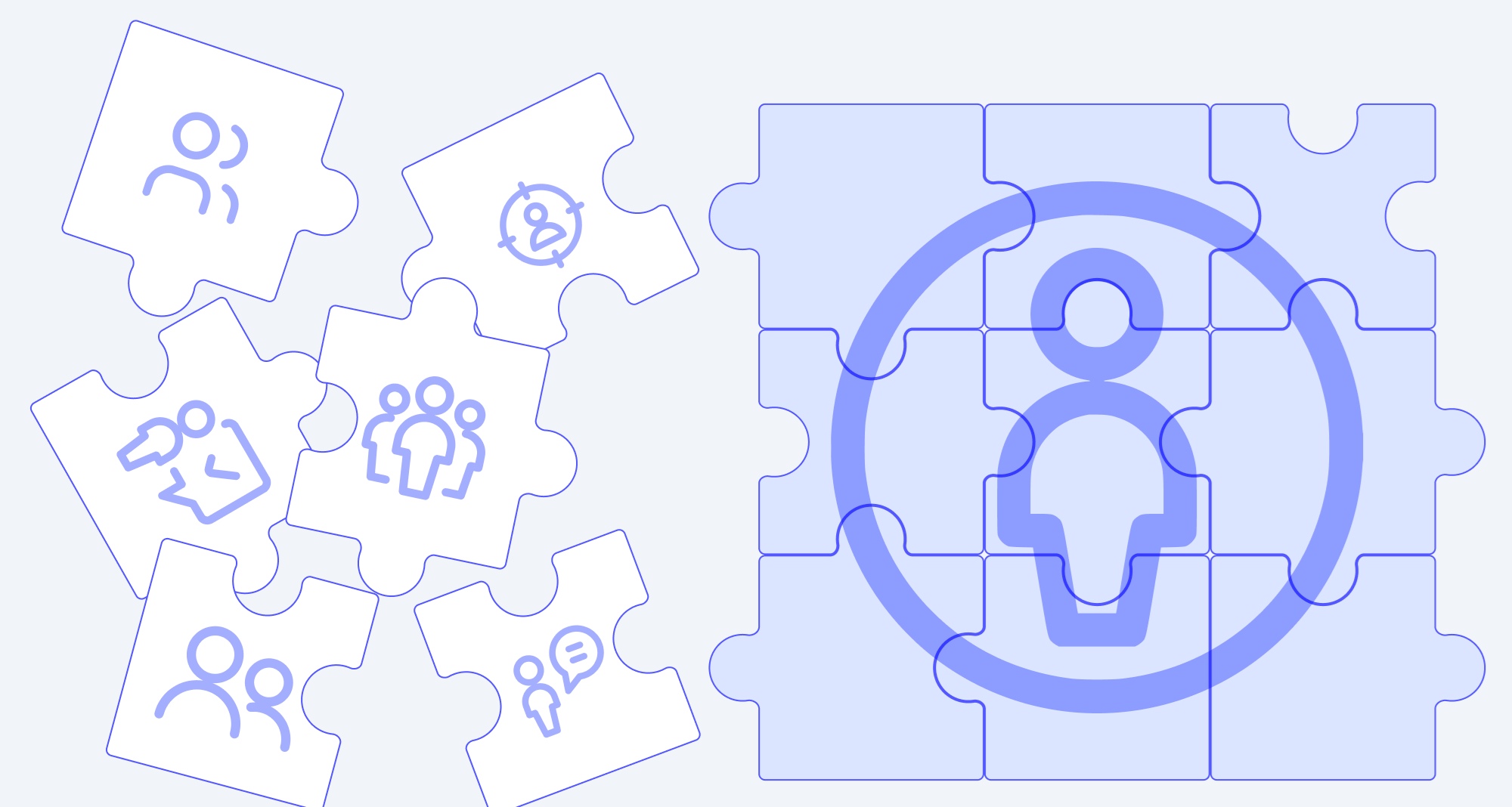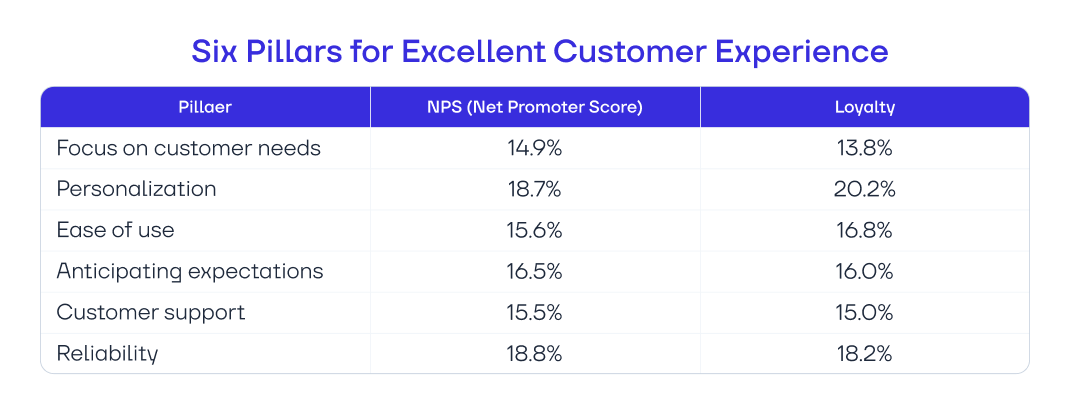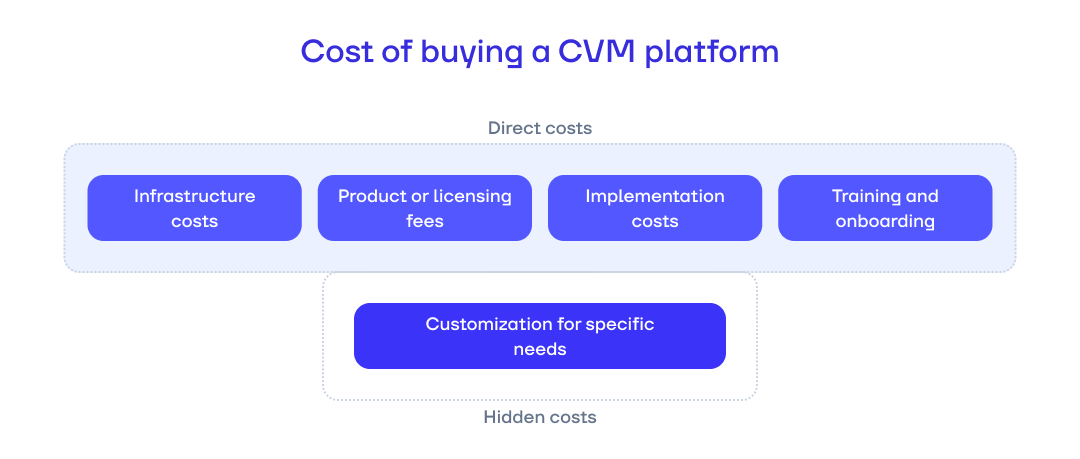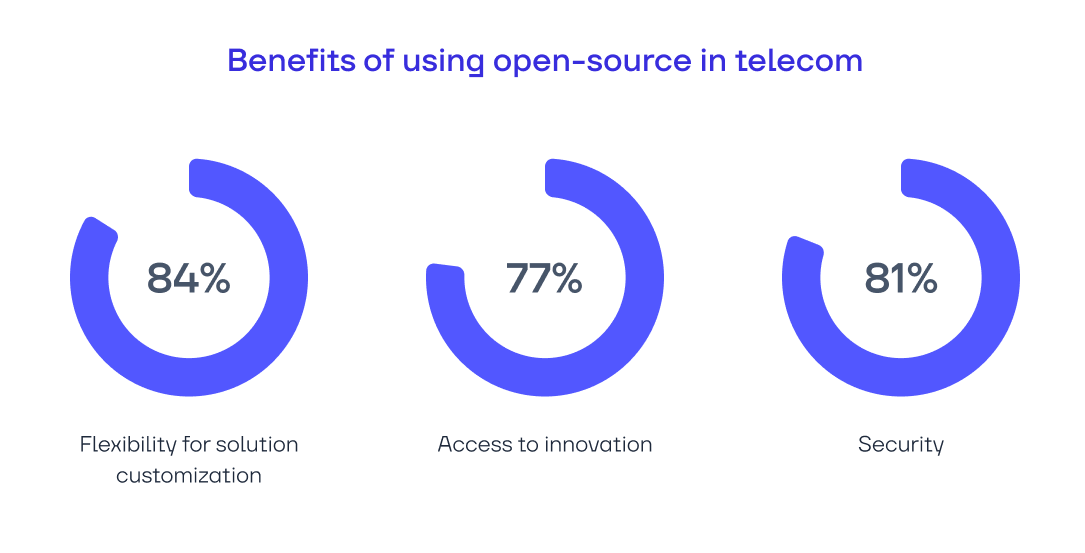Build vs Buy CVM Platform: The Ultimate Guide to Choosing the Right CVM Strategy

Key Functions of a Modern Customer Experience Management System
Customer Value Management (CVM) is more than just marketing automation. It's a strategic approach to maximizing customer value throughout the entire lifecycle. Modern enterprise Customer Value Management technologies help businesses build lasting relationships with their customers by shifting the focus from one-off transactions to sustainable profit growth through increased engagement and loyalty.KPMG surveyed 2,970 companies across 23 countries to identify what makes for a great customer experience. The respondents came from a wide range of industries, including banking, telecom, retail, logistics, and the public sector.
The survey revealed six core pillars that define strong customer experience. They are summarized in the table below.

There are six key elements that contribute to a positive customer experience. Personalization carrying the most weight.
Source: Beyond the Noise: Orchestrating AI-Driven Customer Excellence. Global Customer Experience Excellence 2024 (KPMG)
To achieve true maturity in customer relationship management, companies need more than just marketing automation. They need to embed CVM into their core business processes. When that happens, personalization becomes standard practice, and anticipating customer needs turns into a powerful competitive edge.
There’s no one-size-fits-all path to an effective CVM system. Businesses face a key decision: buy a ready-made system vs develop a customer management platform tailored to their specific needs. Both routes come with distinct advantages—as well as their own set of challenges. Let’s take a closer look at what each approach involves and what to consider when making your choice.
Explore how technology is helping the telecom industry tackle the challenges of 2025
The Buy Approach: What Does a Ready-Made Enterprise CVM Solution Cost
Choosing the Buy route means going with an out-of-the-box CVM platform from an external provider: whether it’s hosted on-premise or on-cloud. It’s a fast track to launching a scalable, feature-rich system with a clear roadmap for future growth.Here’s a closer look at the key advantages and potential drawbacks of going with a ready-made CVM solution.
Benefits of the Buy Approach
Sometimes, it just makes more sense to buy than build. Here’s why choosing a ready-made CVM solution can give your business a real edge:Proven Performance. With an off-the-shelf CVM system, you know what you’re getting: it’s a tried-and-tested product already delivering value for other companies. You avoid the risks that come with custom development, where the end result might not meet your expectations, solve all your needs, or worse, require major rework. That uncertainty can slow you down and derail your business goals.
Faster Time-to-Market. A ready-made solution can be up and running in as little as 3 to 6 months, including any necessary customizations and integrations. For instance, it took just 4 months for SberMobile to roll out EW Marketing Platform. Compare that to building your own system from scratch, which can easily take 12 to 18 months—or more.
Predictable Costs. CVM investment analysis shows that with a ready-made solution, both the initial investment and ongoing maintenance costs are clear from the start—there’s little risk of unexpected expenses. Deployment is handled by the vendor’s team, so there’s no need to hire or train additional in-house specialists.
Some platforms, like EW MMP, even offer Revenue Sharing model. That means you can pay for the solution gradually, using the profits it generates. This approach lowers upfront costs and makes it easier to get CVM system implementation strategy off the ground.
Built-In Best Practices. CVM platforms are developed with the benefit of the vendor’s experience across multiple industries and deployments. Along with the technology, you get access to proven strategies for customer engagement—ready-to-use playbooks, effective segmentation techniques, retention workflows, and personalization tools that are already battle-tested.
Case Study. How MegaFon Tajikistan Boosted Conversions with Targeted CVM
MegaFon Tajikistan needed to promote a new children’s service to a very specific audience. To improve offer relevance and drive conversions, the CVM team first segmented users by social status, age, mobile spending, and internet consumption patterns.
Then, they expanded the target audience using a social graph—identifying friends of subscribers in the initial segment. As a result, the campaign achieved a 2% response rate.
Read the full case study
User-Friendly for Business Teams. Ease of use is a top priority for developers of proprietary CVM platforms. That means intuitive interfaces and automation that simplify routine tasks for business users. For example, EW MMP comes with pre-built campaign templates and communication scenarios. Early on, your CVM team can rely on these out-of-the-box tools instead of designing everything from scratch. As your team gains experience, those templates can be refined or replaced with custom ones.
Technical Support. System maintenance, regular updates, and custom enhancements are all handled by the vendor under the terms of the service agreement. Your internal teams don’t need to troubleshoot issues or upgrade the platform on their own, freeing them up to focus on their core responsibilities.
.png)
EW MMP includes ready-to-use templates for offers, content, and entire campaigns helping clients move faster and reduce the risk of errors
Direct Costs
When purchasing a ready-made CVM solution, businesses should be prepared for several types of direct expenses:
Product or Licensing Fees. This is the core cost of the solution. It typically includes the platform itself and a support package, which covers help with day-to-day issues as well as product enhancements on request.
Infrastructure Costs. If the solution is deployed on-premise, you’ll need to budget for hardware procurement. For cloud-based models, infrastructure costs come in the form of IaaS and PaaS fees to host and run the system.
Implementation Costs. Even a ready-to-use CVM platform requires initial setup connecting it to your internal systems architecture and adapting it to your specific business logic. The cost of this work varies depending on the complexity of your existing infrastructure.
Training and Onboarding. Basic training is usually included in the cost of the product, as is the case with Eastwind. Additional training sessions, such as deep dives into best practices or new features, are available on demand if the client wants to further upskill their team.
“At Eastwind, implementation goes far beyond just installing software and configuring settings. We help clients migrate from their previous systems, share best practices, train their teams to work effectively with the new platform, and if needed, we can even help build a CVM team from the ground up.”
— Roman Vasiliev,
Chief Commercial Officer at Eastwind
Hidden Costs
Even with a well-defined budget, the Buy approach can involve expenses that aren’t immediately obvious at the start of the project. These should be factored into your enterprise CVM strategic decision-making process.
Customization for Specific Needs. Off-the-shelf solutions typically cover 80–90% of standard business requirements, but every organization has its own unique workflows. Adapting the system to handle custom logic, niche communication channels, or integrations with legacy infrastructure may require extra development and additional costs. These could include vendor service fees or the purchase of new hardware and components. Most customization needs are discussed and priced during the contract phase. However, any changes or enhancements requested after the fact will likely come with additional charges.

Ready-Made CVM Implementation Risks
When deciding on Customer Value Management Build vs Buy approach, it’s important to look beyond features and consider the long-term reliability of the vendor. Even the best solution today can lose its value if it lacks strong technical support and ongoing development.
Vendor Lock-In. With a proprietary solution, all system changes must go through the vendor. That means your ability to influence priorities and timelines is limited. Your requests will compete with those of other clients and depend on the vendor’s product roadmap and internal capacity. As a result, critical updates or features may be delayed, slowing down your own product and service development.
Cost of Scaling and Enhancements. Cloud-based platforms often use a “pay as you grow” model—license costs increase as your number of users, channels, or transactions grows. With on-premise deployments, additional customizations usually require separate payments. If these aren’t budgeted for upfront, they may have to wait for the next planning cycle. That said, some vendors are flexible and may agree to implement enhancements with deferred payment, helping clients move forward faster.
Slow Product Evolution. Proprietary platforms evolve according to the vendor’s internal roadmap, which may not always align with your priorities. If critical features are delivered too late—or not at all—it can slow down your business innovation. In such cases, companies often consider switching to another solution, which brings new costs and complexities.
Inconsistent Technical Support. Some vendors outsource their support services, which can lead to slower response times and lower-quality assistance due to limited expertise. Delays in resolving issues may frustrate teams and eventually push businesses to abandon the solution—incurring additional costs.
While the Buy approach helps reduce many technical and implementation risks, it does require a thoughtful selection process and ongoing engagement with the vendor. To stay flexible, it’s wise to set aside a budget for potential customizations and future upgrades from the outset.
The Build Approach: Cost of Developing CVM Solution
Building a CVM platform in-house comes with clear advantages: it’s tailored to your company’s exact needs, aligned with your business processes, and built around your existing infrastructure. But those benefits also come with risks: longer implementation timelines, the cost of maintaining an internal team, and more. Let’s break down what goes into the cost of building a CVM solution from scratch, and weigh the pros and cons of this approach.
Advantages of Building In-House
When you build your own CVM system, you design it around your specific business goals and operational nuances. Success depends on your budget and the expertise of your in-house team.
Flexibility. An in-house CVM platform is shaped by your business model, strategy, customer base, and existing tech stack. Unlike off-the-shelf solutions, it can be easily adapted to your needs, with fast turnaround on changes and improvements and no vendor roadmaps to wait on.
Long-Term Scalability. As your customer base grows and your marketing tasks become more complex, an internal system can evolve quickly provided your team has the right skills. With proprietary platforms, you're often at the mercy of the vendor’s priorities and timelines for enhancements.
Open-Source Community Support. Custom solutions are often built on open-source technologies supported by a wide developer community. These communities regularly implement new modules, libraries, and features, sometimes enabling faster innovation than what you’d get from a vendor’s closed development cycle.
Full Transparency and Control. When you build your own system, you can embed your internal security standards and compliance requirements from day one. This is especially important in highly regulated industries like banking, where specific rules govern customer communication and advertising content.
Up next our CVM software selection guide, we’ll explore the key cost factors involved in developing and rolling out a custom-built Customer Value Management platform.

Red Hat surveyed 1,296 IT leaders in the telecom sector to learn how open-source software is benefiting their organizations.
Source: Red Hat’s The State of Enterprise Open Source Report: Telecommunications Industry Highlights (Red Hat)
Direct Costs
Building a CVM system in-house is an investment that goes far beyond software—it’s also an investment in people, infrastructure, and internal processes. Here are the key cost areas to consider while Customer Value Management software comparison:
Development Team Expenses. You’ll need a full team to build and maintain a CVM platform: an architect, backend and frontend developers, DevOps engineers, analysts, and QA testers. If your current staff doesn’t cover all these roles, you’ll need to hire and onboard new specialists—which means both time and money.
Infrastructure Costs. Hardware expenses for in-house development can be comparable to those in the Buy approach. The difference is, with Build, your team is fully responsible for selecting, purchasing, and setting up the infrastructure. With a vendor solution, this work is usually handled for you. You’ll also need to account for future infrastructure needs, since maintaining and scaling the platform will fall entirely on your team.
Testing and Debugging Costs. Complex communication workflows require rigorous quality control before the system goes live. With a commercial CVM platform, this process is included in the package and follows a proven workflow. With a custom build, testing is your responsibility—and can be time-consuming. Errors in logic or channel integration can result in spam, damage to your brand reputation, and customer churn.
Ongoing Maintenance and Updates. The launch is just the beginning. Your team will need to handle bug fixes, library updates, integrations with new communication channels, and ongoing feature requests from marketing. These needs create a continuous load on your resources—and your budget.
“We’ve been developing our CVM solution for over a decade. Today, clients have access to the third generation of our AdTarget platform. Over the years, we’ve evolved from early-stage concepts to a mature, enterprise-grade solution. More than 100,000 development hours have gone into the product, and it now includes hundreds of features. A dedicated team of 30+ experts continues to work on it every day.
It’s a long and costly journey for any individual company to build something like this from scratch. We’ve already done the heavy lifting—and we’re ready to share that experience. Our clients can focus their efforts where it matters most: working with data, optimizing smart communication channels, and automating customer engagement to deliver real, measurable business impact.”
— Roman Vasiliev,
Chief Commercial Officer at Eastwind
Hidden Costs of Developing CVM Solution
Beyond the direct budget, building a CVM system in-house also demands time, expertise, and flexibility to handle unexpected challenges.
Time Spent on Research and Planning. Before writing a single line of code, there’s a significant analytical phase: studying CVM best practices, gathering requirements from internal stakeholders, designing system architecture, and mapping out a user-friendly experience. Skipping or rushing this step can cause major issues later.
Reworking Poor Decisions. Without deep expertise in CVM strategy and communications, teams may initially make the wrong architectural choices. These missteps can be costly to fix and may require rethinking large parts of the system mid-project.
Technical Debt. Quick fixes and shortcuts taken to deliver a minimum viable product often pile up as technical debt. Over time, this debt makes every future change slower, more complex, and more expensive—hampering innovation and agility.

Source: The Global CTO Survey 2024/25 Report (STX Next)
Risks of Building an Enterprise Customer Value System from Scratch
Even with a strong team and a healthy budget, the Build approach comes with its own set of business risks.
Poor User Experience. Open-source tools are often built by developers—for developers. As a result, UX/UI can take a back seat, making the platform less intuitive for business users. Configuration may be more complex, and a clunky interface can slow down even the most experienced teams, reducing overall efficiency.
Dependency on Internal Talent. When you build in-house, the direction of a platform and pace of development depend entirely on your team’s capabilities. There’s a risk of fragmented progress, where focus shifts to short-term tasks and critical long-term improvements are neglected. By contrast, vendors draw on feedback from dozens of clients, track industry trends, and develop products with a forward-looking strategy.
Loss of Key Team Members. If a lead architect or team lead leaves, development can stall. Transferring their knowledge to new team members takes time—and without proper handover, important architectural decisions may be lost or misunderstood.
No Dedicated Support. Unlike vendor solutions, there’s no formal support team to fall back on. Your internal developers must handle all issues, which can be time-consuming and resource-intensive. While open-source communities can be helpful, there’s no guarantee of quick, clear, or reliable answers when you need them most.
According to research by STX Next, 91% of CTOs cite technical debt as their biggest challenge in 2024. Budget constraints limit the work of 52% of technical leaders, while 42% report difficulties with employee retention.
Ultimately, the Build approach makes sense only when a company has a dedicated product team, along with a solid budget and implementation timeline. Without these, the risks of overspending and accumulating technical debt grow significantly. That’s why many businesses opt for ready-made CVM platforms—they cover most core business needs out of the box, allowing teams to focus on tailoring the solution to their specific context rather than reinventing the foundational infrastructure.
Which CVM Systems Are Better: Custom-Built or Off-the-Shelf
Choosing to build or to buy a CVM platform isn’t just a tech decision—it’s a strategic one. The right choice depends on your team’s maturity, business priorities, planning horizon, and willingness to invest in technology. The table below will help you determine which approach is a better fit for your company.
CVM Solutions: Build vs Buy Comparison Table
| Category | Build (developed from scratch) | Buy (off-the-shelf solution) |
| Business impact | Deep customization. You can build a standalone product, if you're ready to invest in it consistently. | Ability to quickly automate marketing, launch campaigns, and test hypotheses. |
| Total Cost of Ownership (TCO) | High upfront investment: team, architecture, infrastructure, and ongoing support. | Clear payment structure for purchase and implementation. Revenue Sharing model available, allowing gradual buyout of the product. |
| Break-even point | Takes longer to deliver initial results. | Faster time-to-value thanks to earlier launch and quicker project payback. |
| Implementation time | 12–18 months or more for complex architectures. | 3–6 months. |
| Team requirements | A stable team with expertise in architecture, load testing, security, and data engineering. | The CVM team focuses on business logic, while the vendor handles the technical implementation. |
| Flexibility | Maximum, if the architecture is well-designed. | Depends on the platform’s capabilities, but sufficient for most use cases. |
| Reliability and stability | System stability depends on code quality, processes, and team maturity. | Off-the-shelf solutions are battle-tested across dozens or even hundreds of use cases. Reliability and support response times are defined in the SLA. |
If your goal is to quickly automate customer communications and start seeing results within 3–6 months, the Buy approach makes the most sense. It lets you focus on business outcomes instead of building a platform from scratch. If speed isn’t a priority and you're ready to invest time and resources into developing in-house expertise, the Build path may be worth exploring.
To accelerate your marketing automation and start generating revenue faster, consider EW Marketing Platform. With advanced personalization and a focus on delivering great customer experiences, it helps boost customer LTV and your bottom line.
Discover how EW Marketing Platform can support your business goals.
